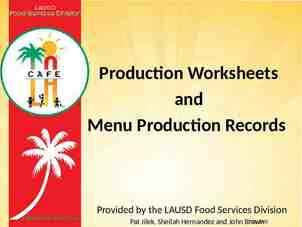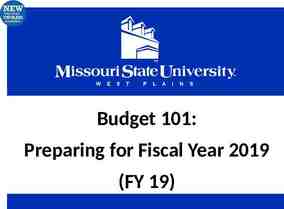Nutrition Care Process KNH 411
38 Slides552.36 KB
Nutrition Care Process KNH 411
ADA NUTRITION CARE PROCESS AND MODEL Screening & Referral System Ø Ø Ø Identify risk factors Use appropriate tools and methods Involve interdisciplinary collaboration Nutrition Assessment Ø Obtain/collect timely and appropriate data Ø Analyze/interpret with evidence - based standards ØDocument Nutrition Diagnosis Ø Identify and label problem Ø Determine cause/contributing risk factors Ø Cluster signs and symptoms/ defining characteristics Ø Document Relationship Between Patient/Client/Group & Dietetics Professional Nutrition Monitoring and Evaluation Ø Monitor progress Ø Measure outcome indicators Ø Evaluate outcomes Ø Document Ø Ø Ø Ø Outcomes Management Sys tem Monitor the success of the Nutrition Care Process implementation Evaluate the impact with aggregate data Identify and analyze causes of less than optimal performance and outcomes Refine the use of the Nutrition Care Process Nutrition Intervention Ø Plan nutrition intervention · Formulate goals and determine a plan of action Ø Implement the nutrition intervention · Care is delivered and actions are carried out Ø Document
ADA’s Nutrition Care Process Steps Nutrition Assessment Nutrition Diagnosis Nutrition Intervention Nutrition Monitoring and Evaluation
Nutrition Assessment (Definition) “A systematic process of obtaining, verifying, and interpreting data in order to make decisions about the nature and cause of nutrition-related problems.” Lacey and Pritchett, JADA 2003;103:1061-1072.
Nutrition Assessment Components Gather data, considering Dietary intake; consequences of condition; physical, psychological, behavior conditions; knowledge, readiness to change, potential for change Compare to relevant standards What is normal What can you do to fix Identify possible problem areas ADIME (anthroplymetrics, biochemical, clinical, dietary intake)
Nutrition Assessment: Critical Thinking Observe Verbal and nonverbal Determining appropriate data to collect Look at key aspects Selecting assessment tools Distinguishing relevant from irrelevant data Organizing data Figure out what client needs and implement Determining when problems require referral
ADA’s Nutrition Care Process Steps Nutrition Assessment Nutrition Diagnosis Nutrition Intervention Nutrition Monitoring and Evaluation
Nutrition Diagnosis Nutritional problem Diagnose problems associated with disease Names and describes the problem What are you going to do to solve? Problem may already exist, or may be at risk of occurring Not a medical diagnosis
Nutrition Dx Domains: Intake Defined as “actual problems related to intake of energy, nutrients, fluids, bioactive substances through oral diet or nutrition support (enteral or parenteral nutrition) Class: Calorie energy balance (weight gain) Class: Oral or nutrition support intake Post operation (type of diet) Class: Fluid intake balance Renal patients Class: Bioactive substances balance Metabolic, someone missing an enzyme Class: Nutrient balance Deficiencies
Nutrition Dx Domains: Clinical Defined as “nutritional findings/problems identified that relate to medical or physical conditions Class: functional balance Physical or mechanical condition Class: Biochemical balance Ability to metabolize nutrients Class: weight balance Chronic weight changes
Nutrition Dx Domains: Behavioral-Environmental Defined as “nutritional findings/problems identified that relate to knowledge, attitudes/beliefs, physical environment, or access to food and food safety Class: knowledge and beliefs State of the disease Class: physical activity, balance and function How they get around/function Class: food safety and access Economic status
Nutrition Diagnosis Components Problem – diagnostic label Etiology – cause, contributing risk factor Signs/Symptoms Signs – observable and measureable Symptoms – what the subject feels/expresses (objective)
Nutrition Diagnosis Components Problem Describes alterations in pt’s nutritional status Diagnostic labels Impaired Altered Inadequate/excessive Inappropriate Swallowing difficulty
Nutrition Diagnosis Components Etiology Related factors that contribute to problem Identifies cause of the problem Helps determine whether nutrition intervention will improve problem Linked to problem
Nutrition Diagnosis Components Etiology Excessive calorie intake related to regular consumption of large portions of high-fat meals Swallowing difficulty related to stroke
Nutrition Diagnosis Components Signs/Symptoms Evidence Linked to etiology
Nutrition Diagnosis Components Etiology Excessive calorie intake “related to” regular consumption of large portions of high-fat meals as evidenced by diet history and weight status Swallowing difficulty related to stroke as evidenced by coughing following drinking of thin liquids
Nutrition Diagnosis Excessive calorie intake “related to” regular consumption of large portions of high-fat meals “as evidenced by” diet history & 12 lb wt gain over last 18 mo
Nutrition Diagnosis Components Food, nutrition and nutrition-related knowledge deficit R/T lack of education on infant feeding practices as evidenced by infant receiving bedtime juice in a bottle Altered GI function R/T ileal resection as evidenced by medical history and dumping syndrome symptoms after meals
Nutrition Diagnosis Components Nutrition Diagnosis Statement should be: clear, concise specific related to one problem accurate based on reliable, accurate assessment data
Nutritional vs Medical Dx Medical Diagnosis Nutritional Diagnosis Diabetes Increased blood glucose, increased carbohydrate intake Trauma and closed head injury Total nutrition support Hydration, increased energy needs Liver failure Blood glucose stability (insulin) s/s- increased blood glucose levels
Nutritional vs Medical Dx Medical Dx Nutritional Diagnosis Obesity Take in more calories than burning Lack of access to food Dependence mechanical ventilation Excessive energy intake Loading with carbohydrates Anorexia nervosa Decreased caloric intake Undesirable food choices Seen by diet history and weight history
ADA’s Nutrition Care Process Steps Nutrition Assessment Nutrition Diagnosis Nutrition Intervention Nutrition Monitoring and Evaluation
Nutrition Intervention Definition “Purposely-planned actions designed with the intent of changing a nutrition-related behavior, risk factor, environmental condition, or aspect of health status for an individual, a target group, or population at large.” – Lacey and Pritchett, JADA 2003;103:1061-1072 Directed at the etiology or effects of a diagnosis Create a plan for the patient
Intervention Objectives Should be patient-centered Must be achievable Must be measureable, quantifiable, have a goal/endpoint Stated in behavioral terms Pt and counselor must establish goals together Everyone working with the patient must agree on the plan What will the patient do or achieve if objectives met
Intervention Objectives Problem 1: Involuntary weight loss Objectives: 1. increase calorie intake X calories divided into six small meals 2. gain 10 pounds in one month Give plan and how to acheive
Intervention Objectives Problem 2: Inadequate protein-energy intake 2 poor appetite Objectives: 1. Eat foods high in protein 2. Eat X meals with X amount of protein
Nutrition Intervention Intervention translates assessment data into strategies, activities, or interventions that will enable the patient or client to meet the established objectives. Interventions should be specific What, when, how
Nutrition Intervention Problem 1: Involuntary Weight loss Intervention: (plan of action) 1. Instruct client on options (educate patient) 2. Gradually introduce plan 3. Introduce supplement 4. Plan for implementing and measuring
Nutrition Intervention Problem 2: Inadequate protein-calorie intake 2 poor appetite Intervention: 1. nutrient-dense foods 2. Introduce to socialization
ADA’s Nutrition Care Process Steps Nutrition Assessment Nutrition Diagnosis Nutrition Intervention Nutrition Monitoring and Evaluation
Nutrition Monitoring & Evaluation Components Evaluate outcomes Compare current findings with previous status, intervention goals, and/or reference standards Be specific
What gets Measured? Nutrition Monitoring and Evaluation Types of Outcomes Direct nutrition outcomes Clinical and health status outcomes Patient/client-centered outcomes Healthcare utilization Intermediate-result outcome (first client visit) End-result outcome (follow-up visits)
Nutrition Goals and Objectives Are necessary in order to evaluate Should be achievable Should be directly or indirectly related to nutrition care How effective was your plan?
NCP Example: Acute Care Nutrition Assessment Medical hx: 72 y.o. female admitted with decompensated CHF; heart failure team consulted; has been admitted with same dx x 2 in past month; meds: Lasix and Toprol; current diet order: 2 gram sodium; has lost 5 pounds in 24 hours since admission; Output input by 2 liters Nutrition history: has been told to weigh self daily but has no scale at home. Does not add salt to foods at the table. Noticed swollen face and extremities on day prior to admission. Day before admission ate canned soup for lunch and 3 slices of pizza for dinner; does not restrict fluids; has never received
NCP Example: Acute Care Nutrition Diagnosis 1. Fluid intake concerns relate to dietary discretion and indicated by patient 2. Excessive sodium intake of foods eaten by diet history 3. No previous nutrition education as evidenced by patient results 4. Not self-monitoring, not weighing self
NCP Example: Acute Care Nutrition Intervention 1. low sodium diet 2. go to senior center for assistance 3. attend nutrition programs 4. get scale 5. limit fluids
NCP Example: Acute Care Monitoring and Evaluation 1. Get scale- weight log 2. Get vitals 3. Food log











































